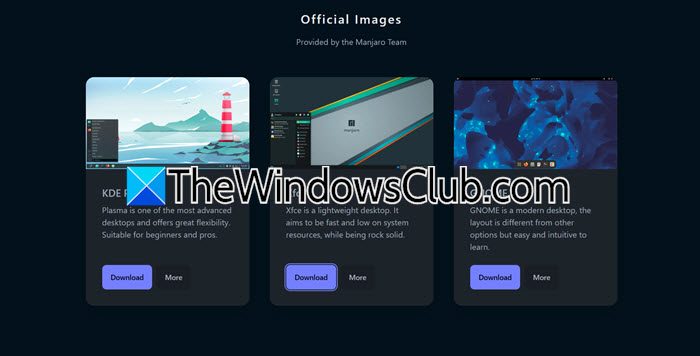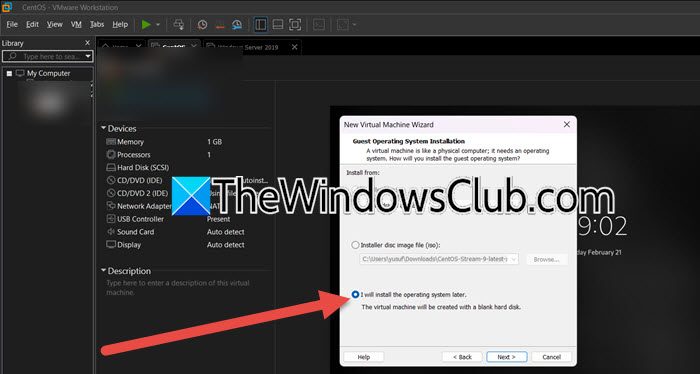Manjora is a Linux distro that aims to be user-friendly and accessible, making it a great choice for both beginners and experienced users. If you are new to the world of Unix-based operating systems, instead of creating a separate partition for it, we recommend you install Manjora on a virtual machine. In this post, we will see how to install the Majora Linux distro on a VMware Workstation.
Install Manjora on Virtual Machine
If you want to install Manjora on a Virtual Machine, follow the steps mentioned below.
- Download and install VMware Workstation
- Get Majora
- Create a virtual machine
- Install Manjora
Let us discuss them in detail.
1] Download and install VMware Workstation
Even though there are various virtual machine tools that you can download and use to create a virtual machine, we decided to go with VMware Workstation which is a free virtual machine tool. We can go ahead and download VMware Workstation Pro and Fusion Pro for free. Once downloaded, you need to run the installer and install it on yours. You also need to ensure that you have at least 8GB of memory, a quad core CPU, and some space.
2] Get Manjora

Manjaro Linux is a free and open-source operating system based on Arch Linux, designed to be user-friendly for both beginners and experienced users. It uses a rolling release model for continuous software updates and supports various desktop environments like Xfce, KDE Plasma, and GNOME, letting users choose their preferred interface. To download the operating system image, you need to majora.org. Since we are going to create a virtual machine, we need to click on the Download button associated with For Workstations and Laptops and then get one of the official images, we went with Xfce and clicked on its Download icon.
3] Create a virtual machine

Let us just create a virtual machine where we are going to install the operating system. To do so, follow the steps mentioned below.
- Open the VMware Workstation on your computer.
- Go to File > New Virtual Machine.
- We will go with the Custom option, so, select it, and click on Next. However, if you are more comfortable with the Typical (Recommended) option, go with it, Custom just allows a bit more flexibility.
- You need to set the Virtual Machine Hardware Compatibility option, you can also go with the default option if you don’t have any preference.
- Now, you need to select the Operating System Media and then choose I will install the operating system later as we are going to feed the ISO file later.
- In the Guest Operating System section, you need to select Linux and in the version, select Other Linux 6.x and later kernel 64-bit. Click on Next.
- Next up, populate in the Name field and then set the location, you can Browse and do so. Once done, click on Next.
- You need to set the processors depending on your system’s threshold. So, do it, and then click on Next.
- Next, allocate the memory and click on Next.
- Set a network connection type, we went with NAT, but you can select anything else as well, depending on your requirements.
- Select I/O Controller, and go with the recommended option if you have no preference.
- Set Disk type and in the next slide, set Disk, where you want to store the data.
- Also, set the disk capacity and disk files
- Finally, go through the Summary and then click on Finish.
Now that we have created the virtual machine, go ahead to install the OS.
4] Install Manjora

Now that we have created the virtual machine, we can go ahead and install Manjora there. To do so, follow the steps mentioned below.
- Right-click on the virtual machine and select Settings.
- Go to the CD/DVD tab, select Use ISO image file, and click on Browse.
- Navigate to the location where you have downloaded the file, and select the ISO image.
- Click on Ok.
- Now, start the virtual machine by clicking on it, and selecting Power on this virtual machine.
- Once the machine launches, you need to go with Launch Installer.
- You need to select the Language, Time zone, and Keyboard Layout
- Follow the on-screen instructions to complete the installation process.
Once done, boot up the machine and start using Manjora.
Hopefully, with the help of this post, you will be able to use Manjora in VMware Workstation.
How do I install Manjaro Linux on VirtualBox?
The process to install Majora Linux on VirtualBox will be the same as it is in VMware. The only difference is the process to create the virtual machine, you can check our guide on how to install Oracle Linux on Oracle VirtualBox to know the steps to create a virtual machine first. And then, go ahead with the installation process as mentioned earlier.
How do I install a virtual machine on a virtual machine?
To install a virtual machine (VM) on another virtual machine, first ensure that nested virtualization is enabled in the host VM’s settings. Then, install a hypervisor like VMware or VirtualBox on the host VM. Open the hypervisor and create a new VM within it, selecting the necessary OS and hardware settings. Follow the installation prompts to set up the guest VM. Ensure your host VM has sufficient resources (CPU, RAM, disk space) to support the nested VM. This way, you can run a VM inside another VM without issues. Remember, performance may be impacted depending on available resources.
Leave a Reply